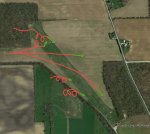I shoot at Youngs in Northern Indiana. Targets are steel set every 100 yards from southeast to northwest, 100 yards to 1k yards. We shoot from covered benches or out of a building at the south end of the range. The prevailing wind shows on the screen shot. The arrows are trying to show the primary effects. When the wind is from the right instead of the left, we get other effects especially a burble in the slot between the benches and 500. There are proper wind flags at 3, 5, 7, and 9. When the corn is up, the bullets see between 1/4 and 1/3 of the wind shown on the flags. Corn is hard to read. When they plant soy, it is easier to read the veg. When the fields are harvested, we get about half of the indicated speed. At Youngs with an east wind and no crops, I have shot between 4 and 5 mils of right to get on the steel at 900.
The wind where you are is important because a little effect at the muzzle has a big effect downrange. Note, we may feel a wind in our face but as the bullet moves downrange the wind seen by the bullet changes from 12 o'clock to 10 o'clock. My terrible "curly-qs" indicate turbulent air. When it is turbulent its effect is not much but sometimes it is flowing and that matters. As the bullet goes downrange, it slows down so the wind has more time to work on it. As the bullet moves away from the ground, the wind speed increases. About 2/3 of the way down the range, the bullet is as high above the ground as it is going to get and the wind has its greatest strength. At this range, there is a low area between 400 and 700 so we get extra high above the ground so extra wind effect.
When the wind is from the west and blowing more than 12 knots on the flags, I can make a cold bore hit at 1k on a 1 mil target about 2/3 of the time. When it is blowing more than 12 knots from the east, it is more like half of the time. At this range it is difficult to spot impacts at 1k, the nature of the berm is to absorb the impact and not throw any dirt. If the impact is visible, second shots usually connect and I can move to a 2/3 mil or 1/3 mil target. At this range, the most difficult target for a reliable cold bore shot is the 2/3 mil steel at 900 - the wind is really weird there. I have never made a cold bore hit on the 1/3 mil target at 900.
This is not an especially difficult range to shoot. Some of you guys have really terrible situations while others have these infinite high-prairie ranges with a nice steady 15 knots from a single direction. Oh well.



